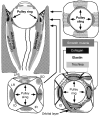Mechanics of the orbita
- PMID: 17314483
- PMCID: PMC2268111
- DOI: 10.1159/000100353
Mechanics of the orbita
Abstract
The oculomotor periphery was formerly regarded as a simple mechanism executing complex behaviors explicitly specified by innervation. It is now recognized that several fundamental aspects of ocular motility are properties of the extraocular muscles (EOMs) and their associated connective tissue pulleys. The Active Pulley Hypothesis proposes that rectus and inferior oblique EOMs have connective tissue soft pulleys that are actively controlled by the action of the EOMs' orbital layers. Functional imaging and histology have suggested that the rectus pulley array constitutes an inner mechanism, similar to a gimbal, that is rotated torsionally around the orbital axis by an outer mechanism driven by the oblique EOMs. This arrangement may mechanically account for several commutative aspects of ocular motor control, including Listing's law, yet permits implementation of noncommutative motility as during the vestibulo-ocular reflex. Recent human behavioral studies, as well neurophysiology in monkeys, are consistent with mechanical rather than central neural implementation of Listing's law. Pathology of the pulley system is associated with predictable patterns of strabismus that are surgically treatable when the pathologic anatomy is characterized by imaging. This mechanical determination may imply limited possibilities for neural adaptation to some ocular motor pathologies, but indicates greater potential for surgical treatments.
Figures




References
-
- Demer JL. Extraocular muscles, chapter 1. In: Jaeger EA, Tasman PR, editors. Duane’s Clinical Ophthalmology. Vol. 1. Philadelphia: Lippincott; 2000. pp. 1–23.
-
- Demer JL. Anatomy of strabismus. In: Taylor D, Hoyt C, editors. Pediatric Ophthalmology and Strabismus. 3. London: Elsevier; 2005. pp. 849–861.
-
- Porter JD, Baker RS, Ragusa RJ, Brueckner JK. Extraocular muscles: basic and clinical aspects of structure and function. Surv Ophthalmol. 1995;39:451–484. - PubMed
-
- Oh SY, Poukens V Demer JL. Quantitative analysis of rectus extraocular muscle layers in monkey and humans. Invest Ophthalmol Vis Sci. 2001;42:10–16. - PubMed
-
- Kono R, Poukens V, Demer JL. Superior oblique muscle layers in monkeys and humans. Invest Ophthalmol Vis Sci. 2005;46:2790–2799. - PubMed
Publication types
MeSH terms
Grants and funding
LinkOut - more resources
Full Text Sources

